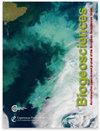北方和冻原环境中冬季土壤二氧化碳通量的环境控制因素
IF 3.9
2区 地球科学
Q1 ECOLOGY
引用次数: 0
摘要
摘要。北极-滨海地区(ABRs)的碳循环是地球碳平衡的重要组成部分,人们日益关注北极-滨海地区变暖对全球气候系统的影响。每年冬季二氧化碳(CO2)预算的不确定性最大,这主要是由于数据可用性面临挑战以及测量的空间覆盖范围有限。本研究的目标是确定纬度梯度(北纬45∘至69∘)上ABR冬季二氧化碳通量的主要环境控制因素,包括四种不同的生态系统类型:闭冠针叶北方森林、疏冠针叶北方森林、直立灌木苔原和匍匐灌木苔原。使用雪堆扩散梯度法计算的二氧化碳通量(n=560)介于 0 至 1.05 克 C m2 d-1 之间。为了评估二氧化碳通量的主要环境控制因素,我们采用了随机森林机器学习方法。我们发现土壤温度是冬季二氧化碳通量的主要控制因素,占模型相对重要性的 68%,但在 0 ∘C 水幕条件下(即土壤温度≈0 ∘C 和液态水与土壤孔隙中的冰共存)出现土壤液态水时除外。在零幕条件下,液态水含量成为二氧化碳通量的主要控制因素,占模型相对重要性的 87%。我们观察到,在完全冻结的土壤(RMSE=0.024 gCm-2d-1;平均 FCO2 的 70.3%)和冰点附近的土壤(RMSE=0.286 gCm-2d-1;平均 FCO2 的 112.4%)中,二氧化碳通量与土壤温度之间呈指数回归关系。与 Tsoil<5 ∘C 时相比,FCO2 随冰点附近 Tsoil 的增加而增加得更快。在零帘条件下,土壤液态水含量的回归系数最大(RMSE=0.137 gCm-2d-1;占平均 FCO2 的 49.1%)。这项研究显示了多个变量在 ABRs 冬季二氧化碳通量时空变异中的作用,并强调在研究冬季土壤碳排放空间变异的驱动因素时,必须考虑北方环境中复杂的植被-雪-土壤相互作用。本文章由计算机程序翻译,如有差异,请以英文原文为准。
Environmental controls of winter soil carbon dioxide fluxes in boreal and tundra environments
Abstract. The carbon cycle in Arctic–boreal regions (ABRs) is an important component of the planetary carbon balance, with growing concerns about the consequences of ABR warming for the global climate system. The greatest uncertainty in annual carbon dioxide (CO2) budgets exists during winter, primarily due to challenges with data availability and limited spatial coverage in measurements. The goal of this study was to determine the main environmental controls of winter CO2 fluxes in ABRs over a latitudinal gradient (45∘ to 69∘ N) featuring four different ecosystem types: closed-crown coniferous boreal forest, open-crown coniferous boreal forest, erect-shrub tundra, and prostrate-shrub tundra. CO2 fluxes calculated using a snowpack diffusion gradient method (n=560) ranged from 0 to 1.05 g C m2 d−1. To assess the dominant environmental controls governing CO2 fluxes, a random forest machine learning approach was used. We identified soil temperature as the main control of winter CO2 fluxes with 68 % of relative model importance, except when soil liquid water occurred during 0 ∘C curtain conditions (i.e., Tsoil≈0 ∘C and liquid water coexist with ice in soil pores). Under zero-curtain conditions, liquid water content became the main control of CO2 fluxes with 87 % of relative model importance. We observed exponential regressions between CO2 fluxes and soil temperature in fully frozen soils (RMSE=0.024 gCm-2d-1; 70.3 % of mean FCO2) and soils around the freezing point (RMSE=0.286 gCm-2d-1; 112.4 % of mean FCO2). FCO2 increases more rapidly with Tsoil around the freezing point than at Tsoil<5 ∘C. In zero-curtain conditions, the strongest regression was found with soil liquid water content (RMSE=0.137 gCm-2d-1; 49.1 % of mean FCO2). This study shows the role of several variables in the spatio-temporal variability in CO2 fluxes in ABRs during winter and highlights that the complex vegetation–snow–soil interactions in northern environments must be considered when studying what drives the spatial variability in soil carbon emissions during winter.
求助全文
通过发布文献求助,成功后即可免费获取论文全文。
去求助
来源期刊

Biogeosciences
环境科学-地球科学综合
CiteScore
8.60
自引率
8.20%
发文量
258
审稿时长
4.2 months
期刊介绍:
Biogeosciences (BG) is an international scientific journal dedicated to the publication and discussion of research articles, short communications and review papers on all aspects of the interactions between the biological, chemical and physical processes in terrestrial or extraterrestrial life with the geosphere, hydrosphere and atmosphere. The objective of the journal is to cut across the boundaries of established sciences and achieve an interdisciplinary view of these interactions. Experimental, conceptual and modelling approaches are welcome.
 求助内容:
求助内容: 应助结果提醒方式:
应助结果提醒方式:


